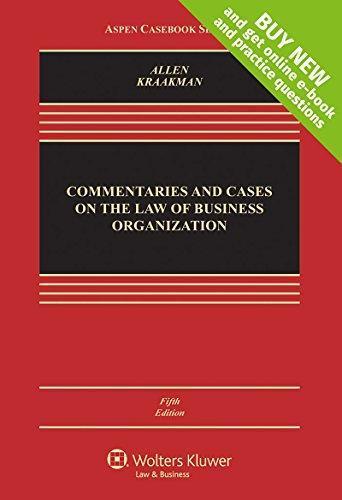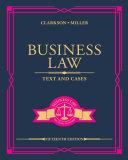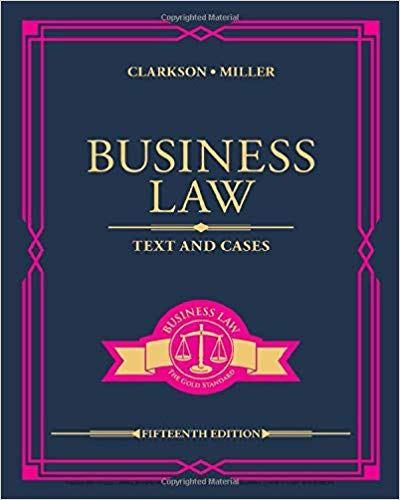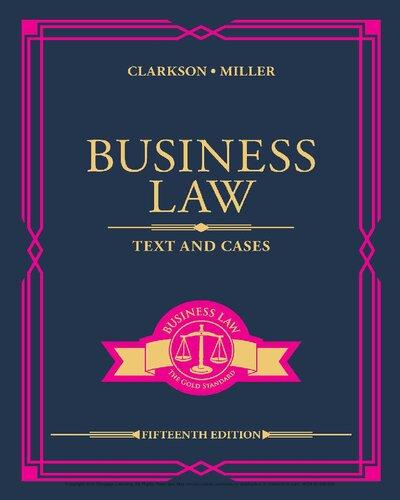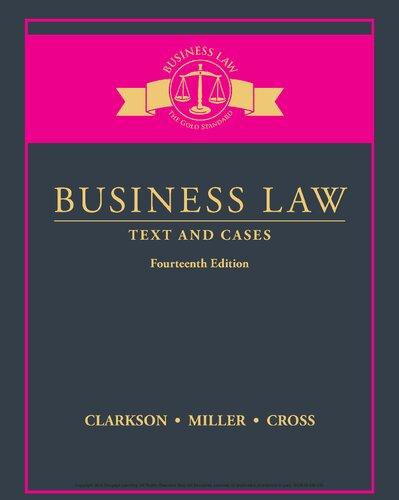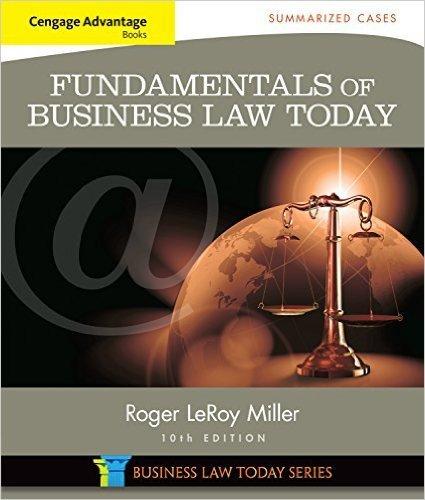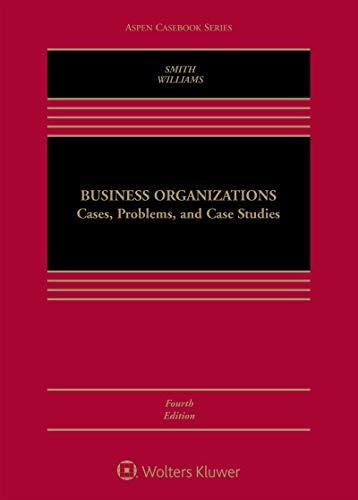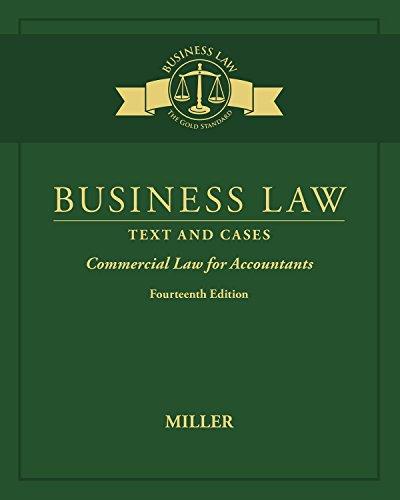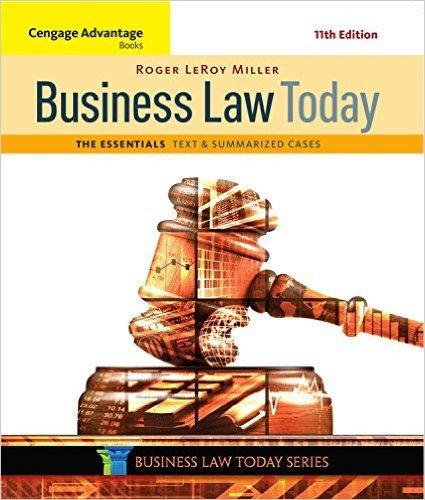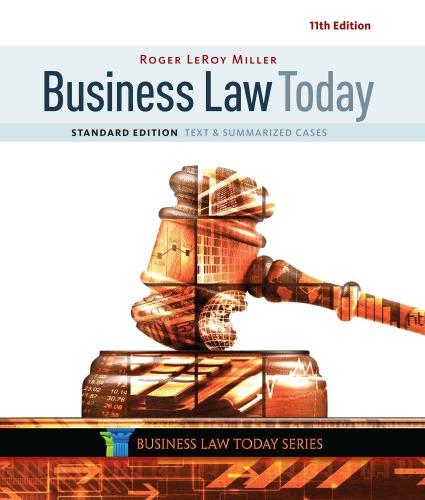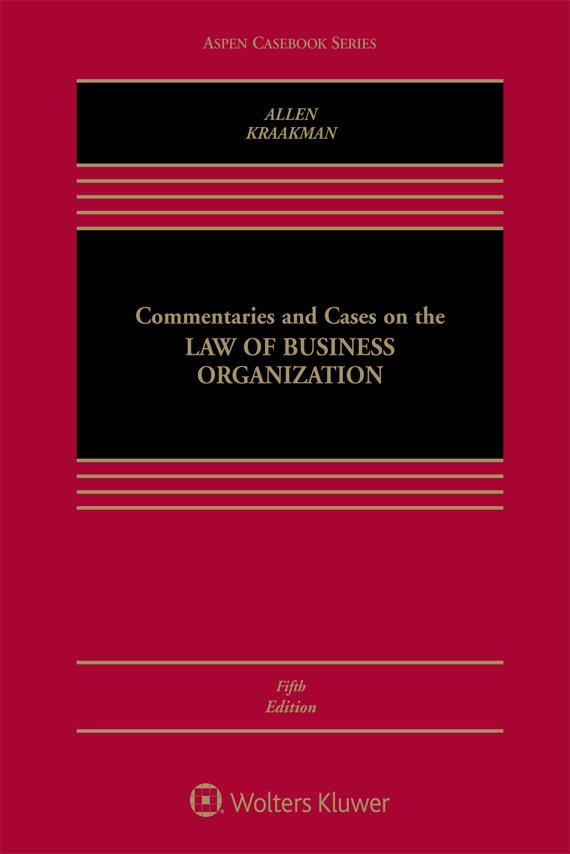CONTENTS
Preface
Acknowledgments
INTRODUCTION
ACTING THROUGH OTHERS: THE LAW OF AGENCY
1.1 INTRODUCTION TO AGENCY
1.2 AGENCY FORMATION,AGENCY TERMINATION, AND PRINCIPAL’S LIABILITY
1.2.1 Formation
1.2.2 Termination
1.2.3 Parties’ ConceptionDoesNot Control Jenson Farms Co. v. Cargill, Inc.
1.2.4 LiabilityinContract
1.2.4.1 Actual andApparent Authority White v. Thomas
1.2.4.2 Inherent Authority Gallant Ins. Co. v. Isaac
1.2.5 LiabilityinTort Humble Oil & Refining Co. v. Martin Hoover v. Sun Oil Co.
1.2.6 LiabilityinTort Under theApparent AuthorityDoctrine
1.3 THE GOVERNANCE OF AGENCY (THE AGENT’SDUTIES)
1.3.1 TheNatureof theAgent’sFiduciaryRelationship
1.3.2 TheAgent’sDutyof LoyaltytothePrincipal Tarnowski v. Resop
1.3.3 TheTrustee’sDutytoTrust Beneficiaries In re Gleeson
JOINT OWNERSHIP OFA BUSINESS:
THE LAW OF PARTNERSHIPS AND LIMITED
LIABILITY COMPANIES
2.1 INTRODUCTION TO PARTNERSHIP: WHY JOINT OWNERSHIP?
William Klein & John C. Coffee, The Need To Assemble At-Risk Capital
2.2 PARTNERSHIP FORMATION
Vohland v. Sweet
2.3 RELATIONS WITH THIRD PARTIES
2.3.1 PartnershipCreditors’ ClaimsAgainst DepartingPartners
2.3.2 Third-PartyClaimsAgainst PartnershipProperty
2.3.3 Claimsof PartnershipCreditorstoPartner’sIndividual Property
2.4 PARTNERSHIP GOVERNANCE AND ISSUES OF AUTHORITY
National Biscuit Co. v. Stroud
2.5 TERMINATION (DISSOLUTION AND DISSOCIATION)
2.5.1 Accountingfor Partnership’sFinancial StatusandPerformance SamplePartnershipBalanceSheet SamplePartnershipIncomeStatement Accountingfor Partners’ Capital Adams v Jarvis
2.5.2 StatutoryDissolutionof aPartnershipat Will
2.5.3 OpportunisticDissolutionandthePartner’sDutyof Loyalty
Page v. Page
2.6 AGENCY CONFLICTS AMONG CO-OWNERS: FIDUCIARY DUTIES
Meinhard v. Salmon
2.7 LIMITED LIABILITY SUCCESSORS OFTHE GENERAL PARTNERSHIP
2.7.1 TheLimitedPartnership
2.7.2 TheLimitedLiabilityPartnership
2.7.3 TheLimitedLiabilityCompany
2.7.3.1 Taxationof LLCs
2.7.3.2 Contractual Flexibility
Pappas et al. v. Tzolis
THE CORPORATE FORM
3.1 INTRODUCTION TO THE CORPORATE FORM
3.2 CREATION OFA FICTIONAL LEGAL ENTITY
3.2.1 ANoteontheHistoryof CorporateFormation
3.2.2 TheProcessof IncorporatingToday
3.2.3 TheArticlesof Incorporation,or “Charter”
3.2.4 TheCorporateBylaws
3.2.5 Shareholders’ Agreements
3.3 LIMITED LIABILITY
Frank Easterbrook & Daniel Fischel, Limited Liability and the Corporation
3.4 TRANSFERABLE SHARES
3.5 CENTRALIZED MANAGEMENT
3.5.1 Legal Constructionof theBoard
3.5.1.1 TheHolder of PrimaryManagement Power Automatic Self-Cleansing Filter Syndicate Co., Ltd. v. Cunninghame
3.5.1.2 StructureandFunctionof theBoard
3.5.1.3 FormalityinBoardOperation
3.5.1.4 ACritiqueof Boards
3.5.2 CorporateOfficers: Agentsof theCorporation Jennings v. Pittsburgh Mercantile Co.
THE PROTECTION OF CREDITORS
4.1 MANDATORY DISCLOSURE
4.2 CAPITAL REGULATION
4.2.1 Financial Statements
4.2.2 DistributionConstraints
4.2.3 Minimum Capital andCapital MaintenanceRequirements
4.3 STANDARD-BASED DUTIES
4.3.1 Director Liability
4.3.2 Creditor Protection: Fraudulent Transfers
4.3.3 Shareholder Liability
4.3.3.1 EquitableSubordination
Costello v. Fazio
4.3.3.2 PiercingtheCorporateVeil
Sea-Land Services, Inc. v. The Pepper Source
Kinney Shoe Corp. v. Polan
4.4 VEIL PIERCING ON BEHALF OF INVOLUNTARY CREDITORS
Walkovszky v. Carlton
D
EBT,EQUITY, AND E
CONOMIC VALUE
5.1 CAPITAL STRUCTURE
5.1.1 Legal Character of Debt
5.1.2 Legal Character of Equity
5.2 BASIC CONCEPTS OF VALUATION
5.2.1 TheTimeValueof Money
5.2.2 RiskandReturn
5.2.3 DiversificationandSystematicRisk
5.3 VALUING ASSETS
5.3.1 TheDiscount CashFlow(DCF) Approach
5.3.2 TheRelevanceof PricesintheSecuritiesMarket In re Emerging Communications Inc., Shareholder Litigation
NORMAL GOVERNANCE: THE VOTING SYSTEM
6.1 INTRODUCTION: SHAREHOLDER VOTING IN THE NEW CORPORATE GOVERNANCE
6.2 ELECTING AND REMOVING DIRECTORS
6.2.1 ElectingDirectors
6.2.2 RemovingDirectors
6.3 SHAREHOLDER MEETINGS AND ALTERNATIVES
6.4 PROXY VOTING AND ITS COSTS
Rosenfeld v. Fairchild Engine & Airplane Corp.
6.5 CLASS VOTING
6.6 SHAREHOLDER INFORMATION RIGHTS
6.7 TECHNIQUES FOR SEPARATING CONTROL FROM CASH FLOW RIGHTS
6.7.1 Circular Control Structures
Speiser v. Baker
6.7.2 VoteBuying
Frank Easterbrook & Daniel Fischel, Voting in Corporate Law
Schreiber v. Carney
6.7.3 ControllingMinorityStructures
Lucian A. Bebchuk, Reinier Kraakman & George G. Triantis, Stock Pyramids, Cross-Ownership, and Dual Class Equity
6.8 MITIGATING A COLLECTIVE PROBLEM TODAY: ACTIVIST INVESTORS
Marcel Kahan & Edward B. Rock, Hedge Funds in Corporate Governance and Corporate Control
6.9 THE FEDERAL PROXY RULES
6.9.1 Rules14a-1Through14a-7: DisclosureandShareholder Communication
6.9.2 Activist InvestorsandtheShort SlateProxyContest
6.9.3 AccesstotheCompany’sProxyStatement: Rule14a-8: Shareholder Proposals
6.9.4 Rule14a-9: TheAntifraudRule
Virginia Bankshares, Inc. v. Sandberg
6.10 FIDUCIARY SUPERINTENDENCE OF SHAREHOLDER VOTING
Schnell v. Chris-Craft Industries, Inc.
NORMAL GOVERNANCE: THE DUTY OF CARE
7.1 INTRODUCTION TO THE DUTY OF CARE
7.2 THE DUTY OF CARE AND THE NEED TO MITIGATE DIRECTOR RISK AVERSION
Gagliardi v. TriFoods International, Inc.
7.3 STATUTORY TECHNIQUES FOR LIMITING DIRECTOR AND OFFICER RISK EXPOSURE
7.3.1 Indemnification
Waltuch v. Conticommodity Services, Inc.
7.3.2 DirectorsandOfficersInsurance
7.4 JUDICIAL PROTECTION: THE BUSINESS JUDGMENT RULE
Kamin v. American Express Co.
7.4.1 UnderstandingtheBusinessJudgment Rule
7.4.2 TheDutyof CareinTakeover Cases: ANote on Smith v. Van Gorkom 244
7.4.3 Additional StatutoryProtection: Authorizationfor Charter ProvisionsWaivingLiabilityfor DueCareViolations
7.5 THE BOARD’SDUTY TO MONITOR: LOSSES “CAUSED” BY BOARD PASSIVITY
Francis v. United Jersey Bank
Graham v. Allis-Chalmers Manufacturing Co.
In the Matter of Michael Marchese
In re Caremark International Inc. Derivative Litigation
In re Citigroup Inc. Shareholder Derivative Litigation
7.6 “KNOWING” VIOLATIONS OF LAW
Miller v. AT&T
THE DUTY OF LOYALTY: CONFLICT TRANSACTIONS
8.1 DUTY TO WHOM?
8.1.1 TheShareholder PrimacyNorm
A.P. Smith Manufacturing Co. v. Barlow
8.1.2 ConstituencyStatutes
8.1.3 DefiningCorporatePurposeintheCharter: Benefit Corporations
8.2 SELF-DEALING TRANSACTIONS
8.2.1 TheDisclosureRequirement
State ex rel. Hayes Oyster Co. v. Keypoint Oyster Co.
Melvin Eisenberg, Self-Interested Transactions in Corporate Law
8.3 THE EFFECT OF APPROVAL BY A DISINTERESTED PARTY
8.3.1 EarlyRegulationof FiduciarySelf-Dealing
8.3.2 Judicial Reviewof Self-DealingToday: TheLimitedRole of SafeHarbor Statutes
Cookies Food Products v. Lakes Warehouse
8.3.3 Judicial ReviewWhenTransactionHasBeenApprovedbya DisinterestedMajorityof theBoard
Melvin Eisenberg, Self-Interested Transactions in Corporate Law
Cooke v. Oolie
8.3.4 Approval byaMinorityof Directors: Special Board Committees
8.3.5 Shareholder Ratificationof Conflict Transactions
Lewis v. Vogelstein
8.4 CORPORATE DIRECTORS AND THE DUTY OF GOOD FAITH
8.5 CONTROLLING SHAREHOLDERS AND THE FAIRNESS STANDARD
8.5.1 Different Treatment for ControllingShareholders?
Sinclair Oil Corp. v. Levien
Weinberger v. UOP, Inc.
8.5.2 Approval byaBoardMinorityof “Independent”Directors: Special Committees
8.6 CORPORATE OPPORTUNITY DOCTRINE
8.6.1 DeterminingWhichOpportunities“Belong”tothe Corporation
8.6.2 WhenMayaFiduciaryTakeaCorporateOpportunity?
8.7 THE DUTY OF LOYALTY IN CLOSE CORPORATIONS
Donahue v. Rodd Electrotype Co.
Frank Easterbrook & Daniel Fischel, Close Corporations and Agency Costs
Smith v. Atlantic Properties, Inc.
EXECUTIVE COMPENSATION
9.1 INTRODUCTION
9.2 THE CHALLENGE OF EXECUTIVE PAY
9.2.1 CreatingIncentivesThat AlignManagersWithInvestors
9.2.2 Political andRegulatoryResponsestoExecutivePay
9.3 ARE U.S.CEOsPAID TOO MUCH?
Lucian Bebchuk & Jesse Fried, Pay Without Performance: Overview of the Issues
Bengt Holmstrom, Pay Without Performance and the Managerial Power Hypothesis: A Comment
9.4 JUDICIAL REVIEW OF COMPENSATION
9.4.1 TheLawof ExecutiveOfficer Compensation
In re The Goldman Sachs Group, Inc.
Shareholder Litigation
9.5 JUDICIAL REVIEW OF DIRECTOR COMPENSATION
Calma v. Templeton
SHAREHOLDER LAWSUITS
10.1 DISTINGUISHING BETWEEN DIRECT AND DERIVATIVE CLAIMS
10.2 SOLVING A COLLECTIVE ACTION PROBLEM: ATTORNEYS’ FEES AND THE INCENTIVE TO SUE
Fletcher v. A.J. Industries, Inc.
10.3 STANDING REQUIREMENTS
10.4 BALANCING THE RIGHTS OF BOARDS TO MANAGE THE CORPORATION AND SHAREHOLDERS’ RIGHTS TO OBTAIN JUDICIAL REVIEW
10.4.1 TheDemandRequirement of Rule23
Levine v. Smith
Rales v. Blasband
10.4.2 Special LitigationCommittees
Zapata Corp. v. Maldonado
In re Oracle Corp. Derivative Litigation
Joy v. North
10.5 DEALING WITH AN ABUNDANCE OF SHAREHOLDER SUITS: EXCLUSIVE FORUM BYLAWS
10.6 SETTLEMENT AND INDEMNIFICATION
10.6.1 Settlement byClassRepresentatives
10.6.2 Settlement bySpecial Committee
Carlton Investments v. TLC Beatrice International Holdings, Inc.
10.7 WHEN ARE DERIVATIVE SUITS IN SHAREHOLDERS’ INTERESTS?
TRANSACTIONS IN CONTROL
11.1 SALES OF CONTROL BLOCKS: THE SELLER’SDUTIES
11.1.1 TheRegulationof Control Premia
Zetlin v. Hanson Holdings, Inc
Perlman v. Feldmann
11.1.2 ADefenseof theMarket RuleinSalesof Control
Frank H. Easterbrook & Daniel R. Fischel, Corporate Control Transactions In re Delphi Financial Group Shareholder Litigation
11.2 SALE OF CORPORATE OFFICE
11.3 LOOTING
11.4 TENDER OFFERS: THE BUYER’SDUTIES
Brascan Ltd. v. Edper Equities Ltd.
11.5 THE HART-SCOTT-RODINO ACT WAITING PERIOD
FUNDAMENTAL TRANSACTIONS: MERGERS AND ACQUISITIONS
12.1 INTRODUCTION
12.2 ECONOMIC MOTIVES FOR MERGERS
12.2.1 IntegrationasaSourceof Value
12.2.2 Other Sourcesof ValueinAcquisitions: Tax,AgencyCosts, andDiversification
12.2.3 Suspect Motivesfor Mergers
12.2.4 DoMergersCreateValue?
12.3 THE EVOLUTION OFTHE U.S.CORPORATE LAW OF MERGERS
12.3.1 WhenMergersWereRare
12.3.2 TheModernEra
12.4 THE ALLOCATION OF POWER IN FUNDAMENTAL TRANSACTIONS
12.5 OVERVIEW OF TRANSACTIONAL FORM
12.5.1 Asset Acquisition
Katz v. Bregman
12.5.2 StockAcquisition
12.5.3 Mergers
12.5.4 Triangular Mergers
12.6 STRUCTURING THE M&ATRANSACTION
12.6.1 Timing
12.6.2 RegulatoryApprovals,Consents,andTitleTransfers
12.6.3 PlanningAroundVotingandAppraisal Rights
12.6.4 DueDiligence,RepresentationsandWarranties,Covenants, andIndemnification
12.6.5 Deal ProtectionsandTerminationFees
12.6.6 AccountingTreatment
12.6.7 ACaseStudy: Excerpt from TimberjackAgreement and Planof Merger
12.7 THE APPRAISAL REMEDY
12.7.1 HistoryandTheory
12.7.2 TheAppraisal AlternativeinInterestedMergers
12.7.3 TheMarket-Out Rule
12.7.4 TheNatureof “Fair Value”
12.7.5 DiscountedCashFlowAnalysis
12.7.6 Current DevelopmentsinAppraisal
12.8 THE DE FACTO MERGER DOCTRINE
Hariton v. Arco Electronics, Inc.
12.9 THE DUTY OF LOYALTY IN CONTROLLED MERGERS
12.9.1 CashMergersor Freeze-Outs
Kahn v. Lynch Communications Systems, Inc.
Kahn v. M&F Worldwide Corp et al
11.9.2 DoControllingShareholdersHaveaDutytoOffer Onlya Fair PriceontheFirst,Tender Offer Stepof aTwoStep Freeze-Out? 520
In re CNX Gas Corporation Shareholders Litigation
PUBLIC CONTESTS FOR CORPORATE CONTROL
13.1 INTRODUCTION
13.2 DEFENDING AGAINST HOSTILE TENDER OFFERS
Unocal Corp. v. Mesa Petroleum Co.
13.3 PRIVATE LAW INNOVATION: THE POISON PILL
13.4 CHOOSING A MERGER OR BUYOUT PARTNER: REVLON,ITS SEQUELS, AND ITS PREQUELS
Smith v. Van Gorkom
Revlon, Inc. v. MacAndrews and Forbes Holdings, Inc.
13.5 PULLING TOGETHER UNOCAL AND REVLON
Paramount Communications, Inc. v. Time, Inc.
Paramount Communications, Inc. v. QVC Network, Inc.
13.6 REGULATION OF TAKEOVERS IN OTHER LEGAL SYSTEMS
13.7 BRINGING TAKEOVERS LAW DOWN TO DATE
Lyondell Chemical Co. v. Ryan
C&J Energy Services, Inc. v. City of Miami General Employees and Sanitation Employees Retirement Trust
13.8 PROTECTING THE DEAL
13.8.1 “NoShops/NoTalks”and“FiduciaryOuts”
13.8.2 Shareholder Lock-ups
Omnicare, Inc. v. NCS Healthcare, Inc.
13.9 STATE ANTITAKEOVER STATUTES
13.9.1 First- andSecond-GenerationAntitakeover Statutes (1968-1987)
13.9.2 Third-GenerationAntitakeover Statutes
13.10 PROXY CONTESTS FOR CORPORATE CONTROL
Blasius Industries, Inc. v. Atlas Corp.
TRADING IN THE CORPORATION’SSECURITIES
14.1 COMMON LAW OF DIRECTORS’ DUTIES WHEN TRADING IN THE CORPORATION’SSTOCK
Goodwin v. Agassiz
14.2 THE CORPORATE LAW OF INSIDER TRADING POST-GOODWIN
Freeman v. Decio
14.3 §16(b) AND RULE 16-bUNDER THE 1934ACT
14.4 EXCHANGE ACT §10(b) AND RULE 10b-5
14.4.1 Evolutionof PrivateRight of ActionUnder §10
14.4.2 Elementsof a10b-5Claim
14.4.3 EarlyRule10b-5Insider TradingLiability: TheEqual AccessTheory
SEC v. Texas Gulf Sulphur Co.
Santa Fe Industries, Inc. v. Green
14.4.4 TheEqual AccessTheoryof Rule10b-5Liability
14.4.5 Elementsof 10b-5Liability: TheFiduciaryDutyTheory
Chiarella v. United States
14.4.6 TheProblem of Tippeesafter Chiarella
Dirks v. SEC
United States v. Newman
14.4.7 NoteonRegulationFD
14.4.8 TheIntroductionof theMisappropriationTheory
United States v. O’Hagan
14.4.9 Civil Liability,Civil Fines,andCriminal Penaltiesfor SecurityFraudViolations
Elkind v. Liggett & Myers, Inc.
14.5 THE OTHER SIDE OF 10B-5: FRAUD-ON-THE-MARKET CLASS ACTIONS
14.5.1 MaterialityandRelianceinFOMClassActions
Basic Inc. v. Levinson
14.5.2 LossCausationin10b-5ClassActions
14.5.3 TheRoleof ClassCertificationinRecent Challengesto FOMActions
14.6 INSIDER TRADING AND FOMCLASS ACTIONS: THE ACADEMIC POLICY DEBATES
14.6.1 TheInsider-TradingDebate
14.6.2 TheAcademicPolicyDebateover FOMClassActions
Table of Cases Index
PREFACETOTHE FIFTH EDITION
This book represents our effort to assist students and non-specialist lawyers to achieve an understanding of the basic principles of law that undergird the legal structures within which business is conducted in the United States. Our approach in this effort is premised upon a functional perspective of law. Thus, we attempt to ask how these legal structures function to produce desired benefits to parties who enter into agreements and relationships, or how legal structures (or rules) add costs and can impede sensible business organization. In this second aspect, the analytical or critical perspective, our point of view is informed through our understanding of basic principles of economics. The book, however, requires of its readers no formal training or understanding of economics. Theconceptsarefor themost part quiteintuitiveandeasilygrasped.
We have organized the book into two segments. The first (and shorter) of these segments — the Introduction and Chapters 1-3 — deals with the fundamentals of organizational law in a business setting. Chapter 1 focuses on agency law, which is no less a predicate for modern enterprises functioning in a market economy than contract or property law. Chapter 2 addresses the partnership form and its modern variants: the limited partnership, limited liability company, and limited liability partnership. Chapter 3 introduces the corporate form, explicitly contrasted against the partnershipanditsvariants,suchastheLLC.
The larger segment of the book, Chapters 4-14, addresses the legal regulation of a variety of actions, decisions, and transactions that involve or concern the modern public corporation. Chapter 4 explores relationships among shareholders, corporations, and corporate creditors. Chapters 5 provides a basic primer on applicable finance concepts useful in understanding issues respecting estimating costs of funding a business and estimating asset values. Chapters 6 and 7 explore what we term “normal governance” — that is, the legal framework that regulates the vast majority of the corporation’s ordinary business activities. Chapter 6 addressestheroutinefunctioningof thevotingsystem,includingtheproxy rules and some current issues in corporate governance. Chapter 7 explores the duty of care, together with the multiple legal devices that insulate
corporate officers and directors from shareholder liability, including, most notably,thebusinessjudgment rule.
Chapters8and13aredevotedtoparticular classes of corporateactions and related shareholder transactions that are subject to more specialized regulation by corporate law. Chapter 8 addresses self-dealing and other potential duty of loyalty issues arising from the conduct of corporate officers, directors, and controlling shareholders. Chapter 9 focuses on the particular challenges of executive compensation. Chapter 10 reviews the law and practice of shareholder derivative suits. Chapter 11 examines transactions in corporate control, including sales of control blocks of shares and tender offers. Chapter 12 addresses the specialized legal treatment of so-called fundamental corporate actions, with special attention to merger and acquisition transactions. Chapter 13 turns to the dramatic topic of conflicts for corporate control, including hostile tender offers and proxycontexts. And finally, Chapter 14 examines the regulation of transactions in shares on the public markets, including such topics as insider tradingandfraudonthemarket.
Throughout, the fifth edition contains substantial updating from the fourth edition, especially respecting the topics of corporate finance, corporate governance, mergers & acquisitions and securities regulations. The basic structure and insights of the book remain unchanged, however. These materials continue to be structured in a way that conforms to the simple insight that much of corporate law can be divided into general governance, on the one hand, and discrete areas of specialized governance on the other. We expect some teachers will present the materials in a different sequence. We have taken care to facilitate alternative approaches by recapping in later chapters points more exhaustively made in earlier onesandbysupplyingcross-referencesfor further review.
The book contains a number of notes that are perhaps a bit longer and more openly explanatory than other authors prefer. In this we have been motivated by our experience as teachers to want to provide a rather full textual basis for a general understanding of each subject. Our aim is to provide for those happy occasions when class gets deeply involved in an interesting discussion. In this event we are comforted by the knowledge that we can move on to the next class knowing that all of the basic information and insights have been made available to the class in the readingassignment.
In the end, what makes this branch of law so interesting (and frustrating) to students, practitioners, and scholars alike is the vital role played in it by the open-textured concept of fiduciary duty. From the early study of agency, to its conclusion with corporate mergers and acquisitions, the field and these materials offer myriad puzzles arising from the admixtureof moralityandefficiencythat isoftenencounteredwhencourts are required to fill in the specifics of a fiduciary’s obligations. In approaching this subject, the book places primary emphasis on the Delaware statute and decisions, as that law grows in its dominant importance for publicly financed corporations in the United States. Opinions by the Delaware Court of Chancery and the Delaware Supreme Court tendtooutnumber casesfrom other jurisdictions.
We must offer very real thanks and appreciation to colleagues and friendswhohavetaught from thesematerialsfor someyearsandwhohave been generous in their comments, contributions, and suggestions. First amongthese is GuhanSubramanian,our talentedcoauthor onseveral prior editions of this Book. Needless to say, we are grateful for his numerous contributions in the past and, like loyal continuing partners, we are fully prepared to hold him intellectually harmless for the novel content of the 5th Edition. Next among those to whom we owe deep gratitude are Victor Brudney, whose teaching materials provided the starting point for this book, and Henry Hansmann, who has commented so richly and so long that it would be difficult to exaggerate our gratitude. Other colleagues have made useful comments and supplied detailed guidance. Among these are Jennifer Arlen, Ryan Bubb, Lucian Bebchuk, Bernard Black, John Coates, Rob Daines, Jill Fisch, Jesse Fried, Jon Hanson, Hon. Jack B. Jacobs,Marcel Kahan,EhudKamar,Vic Khanna,StephenJ.Lubben,Mark Roe, and Hon. Leo Strine. We acknowledge gladly our debt to them. In addition, numerous anonymous reviewers made very helpful comments, andwehopethat theywill findthebookimprovedbecauseof their efforts. Finally, we each owe a debt of gratitude to student researchers and secretarial associates. Among students, some especially stand out for their glad assistance: Alison Gooley, NYU, 1999, of the Bar of New South Wales; Ronnie Deutch, NYU, 2002, of the New York bar; Melissa Anderson, HLS, 2009; Jeffrey Young, HLS, 2010; Maria Parra-Orlandoni, HLS, 2015 and Divya Suwasin, NYU 2016. Susannah Atkins, Carol Bateson, Cara R. Conlin, Linell Hanover, Annie Hard, Barbara Karasinski,
Kimberly Peterson, and Paula Prather offered cheerful and highly competent assistance.Our gratitudeextendstothem all.
February2016
William T Allen Reinier Kraakman
ACKNOWLEDGMENTS
We thank the authors and copyright holders of the following works for permittingtheir inclusioninthisbook:
Bebchuk and Fried, Pay Without Performance: Overview of the Issues, 30J.Corp.L.647(2005).
Bebchuk, Kraakman, and Triantis, Stock Pyramids, Cross-Ownership, and Dual Class Equity, 295ff. in Randall K. Morck, ed., Concentrated CorporateOwnership(2000).
Easterbrook and Fischel, Close Corporations and Agency Costs, 38 Stan.L.Rev.271(1986).StanfordLawReviewbySchool of Law,Stanford University, Copyright © 1986. Reproduced with permission of Stanford LawReviewviaCopyright ClearanceCenter.
EasterbrookandFischel, Corporate Control Transactions, 91Yale L.J. 698, 715-719 (1982). The Yale Law Journal by Yale Law School, Copyright © 1982. Reproduced with permission of Yale Law Journal Company,Inc.viaCopyright ClearanceCenter.
Easterbrook and Fischel, Limited Liability and the Corporation, 52 U. Chi.L.Rev.89,94-97(1985).
Easterbrook and Fischel, Voting in Corporate Law, 26 J.L. & Econ. 395,409-411(1983).
Eisenberg, Self-Interested Transactions in Corporate Law, 13 J. Corp. L. 997, 997-1008 (1988). The Journal of Corporation Law, published by University of Iowa, College of Law, Copyright © 1988. Reproduced with permission of The Journal of Corporation Law via Copyright Clearance Center.
Eisinger, Jesse, Long & Short: Icahu Cries Foul at Perry’s No-Risk Play in Takeover Fight, Wall Street Journal, Eastern Edition, Dec. 15, 2004. Copyright © 2004 by Dow Jones & Company, Inc. Reproduced with permission of Dow Jones & Company, Inc. via Copyright Clearance Center.
Hansmann, Kraakman, and Squire, Law and the Rise of the Firm, 119 Harv. L. Rev. 1333 (2006). Harvard Law Review by Harvard Law Review PublishingAssociation,Copyright ©2006.Reproducedwithpermissionof
Harvard Law Review Publishing Association via Copyright Clearance Center.
Holmstrom, Bengt, Pay Without Performance and the Managerial Power Hypothesis: A Comment,30J.Corp.L.503(2005).
Holzer, Jessica, A “Yes” in Say on Pay, Wall Street Journal, July 8, 2011, Copyright ©2011 by Dow Jones & Company, Inc. Reproduced with permission of Dow Jones & Company, Inc. via Copyright Clearance Center.
Kahan and Rock, Hedge Funds in Corporate Governance and Corporate Control, 155 U. Pa. L. Rev. 1021 (2007). University of Pennsylvania Law Review by University of Pennsylvania Law School, Copyright © 2007. Reproduced with permission of University of PennsylvaniaLawSchool viaCopyright ClearanceCenter.
Markon, Jerry, and Robert Frank, Five Adelphia Officials Arrested on Fraud Charges, Wall Street Journal, Eastern Edition, Jul. 25, 2002. Copyright © 2002 by Dow Jones & Company, Inc. Reproduced with permission of Dow Jones & Company, Inc. via Copyright Clearance Center.
Roe, Mark J., Corporate Strategic Reaction to Mass Tort, 72 Va. L. Rev. 1, 32 (1986). Virginia Law Review Association by Virginia Law Review, Copyright © 1986. Reproduced with permission of Virginia Law ReviewviaCopyright ClearanceCenter.
Staff Writer, Doing Good and Doing Well at Timberland, Wall Street Journal,EasternEdition,Sept.9,2003.Copyright ©2003byDowJones & Company, Inc. Reproduced with permission of Dow Jones & Company, Inc.viaCopyright ClearanceCenter.
Thompson and Thomas, The New Look of Shareholder Litigation: Acquisition-Oriented Class Actions,57Vand.L.Rev.133,166-69(2004).
INTRODUCTION
Like much of civil law, the law of business enterprises is concerned with facilitating voluntary economic relationships. Property law and contract laware the legal bedrockof market economies,but other bodies of laware alsoimportant.Among these are the laws of security interests, money and credit, bankruptcy, intellectual property, agency, and enterprise organization. This book deals primarily with the last, but hardly the least, of thesefields: thelawof enterpriseorganization.Inparticular,weaddress the laws of agency, partnership (and related limited liability entities), and corporations.
Because cooperative economic relationships frequently raise the same recurring problems, the law provides a useful menu of standard forms to address these problems. Thus, the laws of agency, partnership, noncorporate limited liability entities, and corporations can be seen as offering parties a set of standard legal forms from which to choose the form most suited to their needs. The choice of a standard form is implicitly a contractual choice. Moreover, these forms themselves are more or less contractual insofar as they may be customized or fine-tuned by the parties by express agreement — and, of course, with the assistance of expert lawyering. As we shall also see, the laws of agency, partnership, and corporations are not entirely malleable because fiduciary duties grounded in equity — a principal focus of this course — limit the opportunistic use of contractual and even statutory rights. Finally, agency lawas well as the lawof all business entities have a “property” dimension in addition to a contractual dimension, insofar as they may alter the legal rights of third parties as well as the rights of the parties who enter into theseenterpriserelationships.
We beginbyexaminingthe lawof agency.The agency relationship can beimaginedas thesimplest form of business organization.Alternativelyit may be seen as the legal glue that contours the boundaries of a legal enterprise: Which persons have the power to bind the entity contractually and in tort or criminal law, and which persons act outside the entity? Agency lawalso prefigures many of the most basic and difficult problems of corporation law, most particularly those arising from the so-called
fiduciarydutyof loyalty.From agency,we move tothe general partnership —whichwemaythinkof asthesimplest form of ajointlyownedbusiness firm. (For our purposes, a “firm” is a form of business relation that has a temporal dimension, a social identity, and a separate pool of dedicated businessassets.) Andfrom partnershipand other noncorporate forms, we move to our principal subject — the corporate form — which is the most stable, complex, and socially important form inthemenuof businessformsthat thelawprovides.
Before beginning, we will address here two very general themes that run throughout this book. The first is a policy theme: How does one evaluate and critique enterprise law, and what are the goals of enterprise law? The second theme concerns the role that the morally charged language of enterprise law(it is law, after all) plays in its legitimation and enforcement.
We begin with the policy theme. It goes without saying that the fundamental objective of enterprise law — indeed of all law — is to increase social welfare. Yet, this abstract formulation tells us little about how enterprise law should contribute to social welfare or how it might be tweaked to do a better job. Like many other modern commentators on enterprise law, we sometimes assert that good law is “efficient” law, meaning that it maximizes the size of the economic pie (even if the pie’s pieces are allocated quite differently according to whether one is, say, an investor or an employee).1 At other times we assert that the goal of the business corporation is to maximize long-term shareholder wealth. Needless to say, there is a gap of some distance between innocuously statingthat enterpriselawshouldincreasesocial welfareandassertingthat this means furthering the interests of shareholders or other investors of riskcapital.
Some commentators argue that large enterprises such as public corporations should not privilege shareholder interests over those of other constituencies such as creditors, employees, suppliers, customers, or even the interests of society as a whole. We explore these alternative goals in Chapter 4 (The Protection of Creditors), Chapter 7 (Conflict Transactions: The Duty of Loyalty), and Chapter 12 (Public Contests for Corporate Control). Elsewhere, we take the primacy of shareholder interests for granted. This is not because we believe that shareholder ownership of corporations is an indisputable and sacred property right, or that it is an
obvious principle of natural law. Rather, it is partly because we believe that shareholder/investor welfare is a workable if imperfect proxy for social welfare in most situations, and partly because the primacy of shareholder/investor welfare dominates American enterprise law as a matter of pure empirics.The objective of maximizing shareholder welfare runs so deeply through the relevant statutory and case law that it is rarely questioned or even stated, except when the conflict between the interests of shareholders and those of other corporate constituencies grows too acutetoignore.
Once shareholder/investor welfare is identified as the principal objective of enterprise law, it follows easily that economic efficiency is the logical criterion for evaluating enterprise law. Shareholders/investors arethe“equity holders” or “residual claimants” of business entities — a fancy way of saying that they don’t get paid until everyone else is paid first, including business creditors, employees, and suppliers. Any factor that increases residual value of the enterprise to its shareholders (or other equity investors) is “efficient” by this criterion — at least if it does not impose uncompensated costs on third parties such as tort victims. And any factor that reduces the costs of capital, labor, supplies, and the like adds to the residual value of the enterprise. Put differently, efficient law adds to the valueof thefirm just asanyother factor might do,byreducingthecostsof thefirm’sinputsandincreasingthevalueof itsoutputs.
There are at least three specific ways in which enterprise law can enhance the efficiency of enterprises. The first is by providing standard platforms for business entities as well as agency contracts and creditor protections. Where negotiating parties are involved, these platforms are often an integrated set of default terms open to contractual modification. Where third-party rights are at stake, the analogous standard terms are oftenmandatory.Inbothcases,however,standardplatforms save time and effort by allowing parties to do business in shorthand, without reinventing the legal wheel. Second, enterprise law adds value by permitting business actors to modify third-party property rights in circumstances when contract alone cannot do the job. We address this function in Chapters 2 and3, where we demonstrate how legal entities permit investors to divide their assets among different buckets that serve as collateral for different groups of creditors. This power to assign specific assets to support
business creditors is enormously useful and yet, as we will argue, cannot beachievedbycontract alone.
Finally, enterprise law provides a variety of rules and standards collectively termed “fiduciary duties” — that are intended to either prevent or remedy self-interested opportunism by parties within enterprises. The simplest example is that of an agent who agrees to act loyally on behalf of his principal, but is economically motivated to act against his principal’s interests in numerous ways, from colluding with third parties in negotiating contracts on the principal’s behalf to expropriating the principal’s property or private information for his own benefit. This genre of opportunism is a chronic problem in every sort of enterprise, from simple agency relationships to publicly traded corporations. In the academic literature, it is referred to generically as the “agency problem” and the costs that inevitably arise from the fact that agents rather than owners themselves are at work in the enterprise are referred to as “agency costs.” This problem and the costs that it produces are not specific to the law of agency at all. Indeed, these are not legal terms of art. But addressing them lies at the core of the understanding and critical analysisof muchof enterpriselaw.
As the problem of mitigating agency costs implies, evaluating the efficiency of a particular legal rule or a particular reform in enterprise law requires a good deal of knowledge about institutional context and enforcement. Research in the social sciences can be helpful here. But at the very least, clarity is essential about one’s empirical assumptions about the institutional context as well as the weights assigned to particular costs and benefits. In the end, and over time, the balance of costs and benefits generally determines the survivorability of legal doctrine here, as in so manyother areasof thelaw.
However, policy-oriented analysis is certainly not the only aim of the study of organization law by lawyers. If it were, enterprise law would be nothing but a pastiche of applied social sciences — mostly economics and finance perhaps, but with a dash of psychology and organization theory tossedin.The meaning of this imaginary lawwould be wholly captured in phrases such as “efficiency,” “transaction costs,” “collective action problems,” and the “prisoner’s dilemma.” Its rules and standards would be understood as more or less well-supported hypotheses. Individual plaintiffs and defendants would occupy roughly the same status as
laboratory animals behaving in accordance with the vector of their selfinterest and the law’s calibration of incentives. Judges would be the investigators-in-chief.
Needless to say, this Orwellian account of enterprise lawis not the real thing by a long shot, even if traces of applied social science occur in the case law and large deposits of it may be found in the academic literature. The principal statutes of enterprise law, including the statute that will play the most important role in this book — the Delaware General Corporation Law (DGCL) — read like an integrated set of self-contained rules that erect a legal entity, and describe its governance mechanisms. In the aggregate, they seem to rest on social science no more than the blueprints for large buildings do. Similarly, if one reads an opinion handed down by the Delaware Court of Chancery or the Delaware Supreme Court concerning an issue in corporate law, the number of references to “efficiency” or “transaction costs” is vanishingly small in comparison to that of legal terms of art such as “entire fairness” and the “business judgment rule.” Moreover, the language of these opinions is often morally charged and didactic. The authorities cited are statutory provisions and prior case law.This is, in short, law as we know it.The attention to policy concerns is often here, but it resides in the melody rather than in the words. The only remotely “scientific” piece of the typical opinion is the careful attention paid to the facts and institutional context at the outset of the decision. And this resembles anthropology or history more than economics.
Phrased more directly, judges and lawyers occupy a different role than social scientists do. Judges and lawyers are understood to be believers in the language of law. Indeed, they are the high priests and the deacons of the faith. For them, the articulated reason for some judicial act is not simply a concurrence with good policy, but a legally derived cause in itself. In this faith, law is all about the meaning of legal doctrines: statutes, court rules, administrative procedures, judicial precedents, and the rich body of professional learning that allows experienced lawyers to perform their professional functions. These meanings may be unclear at times, but the internal processes of law— canons of construction, rules of authority and judicial processes of discovery, trial and appeal, and even much scholarship — are about clarifying legal meanings as well as their application.Thisisthe“interior”perspectiveonlaw.
How, then, can faith and science freely coexist in the study of enterprise law — and perhaps even in its creation?2 Our long answer to this question lies in the discussion of the materials in this book.The short answer comesinseveral pieces.
The most obvious piece is that the interior perspective on enterprise law comes first in time. The law’s basic entity forms, its morally charged categories, and even the forerunners of today’s business statutes long predate the normative claims made by modern economics. Indeed, some fundamental concepts in organizational economics were inspired by enterprise law. Examples include entire subfields of microeconomics such as “the principal-agent problem,” the idea of “transaction costs,” and the distinctionbetweenproductionbya principal’s agents withina legal entity as distinct from acquiring goods or services from independent contractors inthemarket.
A second aspect of the coexistence of “faith-based” legal analysis and economically oriented policy derives from the policy-making role of the judiciary. Even a judge who is a strict constructionist finds that policymaking choices are inescapably thrust upon her. Linguistic ambiguity aloneoftenrequires ajudgetomakechoices.To be sure, in such situations —andtheyarise frequentlyinthe lawof enterprise organization—courts avoid using concepts like “efficiency” to justify their choices, even if these concepts are central to evaluating the wisdom of the outcome reached. However, this may change over the years as more lawyers trained in economic analysis enter the profession. Even today, one should not underestimate how many lawyers and judges — especially those who are frequently involved in business-related cases — are, if not fully bilingual, able to discourse in the language of economics as well as that of traditional enterprise law. In business law, the lawyer who fails to understand the economics of a problem usually fails to find a satisfactory solutiontotheproblem.
Finally, we hasten to add our prediction that today’s coexistence will never result in policy analysis supplanting enterprise law as we know it. There are two reasons. The first is that the vice of microeconomic theory cannot completely close on the complex institutional structures and transactions encountered in enterprise law. Markets and contracts are incomplete, and information is noisy in the real world. Judgments based on the situational insights of sophisticated lawyers and judges, as
expressed in the language of the law, will ordinarily dominate judgments mechanicallyderivedfrom anabstract policyframework.Secondandeven more important, business actors are not two-dimensional puppets entirely controlled by economic concerns.They are moral individuals (albeit more or less imperfect ones) whose actions often reflect ethical notions as well. In many cases, the soft prodding of conscience or reputation may elicit more legal compliance than will the threat of monetary sanctions. The morally charged language of business lawtakes aim directly at conscience and reputation. For most of us, it is one thing to be scolded by a court for acting inefficiently and quite another to be charged with acting disloyally or in bad faith. Arguably, in fact, some obligations imposed by enterprise law are enforced exclusively by these soft sanctions. And arguably, this is thewayit shouldbe.
1 Those familiar with the literature addressing various definitions of efficiency will recognize that by “efficiency” we mean “Kaldor-Hicks efficiency ” This form of efficiency looks to increasing the size of the value pie In principal, a larger pie is divisible in a way that makes all participants in an enterprise better off Yet efficient law increases Kaldor-Hicks efficiency by increasing the size of the pie, regardless of how the increased pie is divided Kaldor-Hicks efficiency is to be contrasted with “Pareto efficiency,” under which a change is efficient only if the pie increases and every constituent’s piece of pie is also increased The latter criterion is too demanding to serve as a usefulnorm in enterprise law
2 We ask the reader to excuse this phrasing, which borrows from another, more venerable discussion
